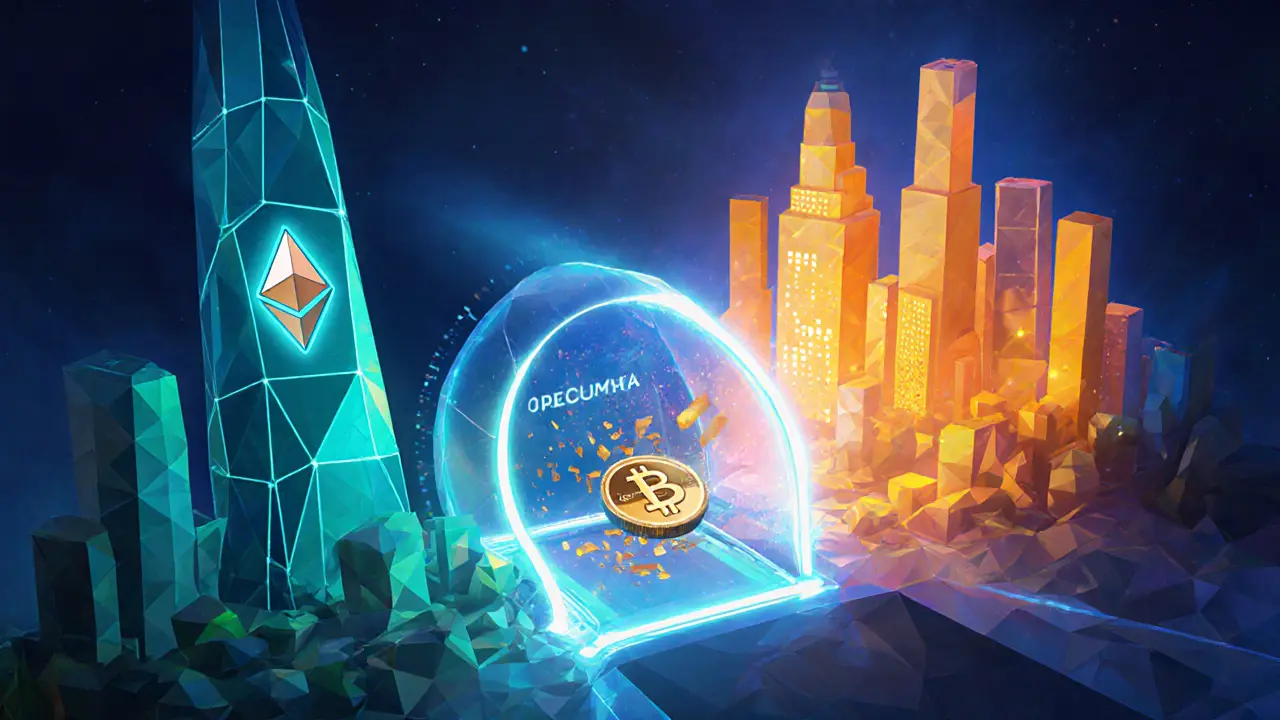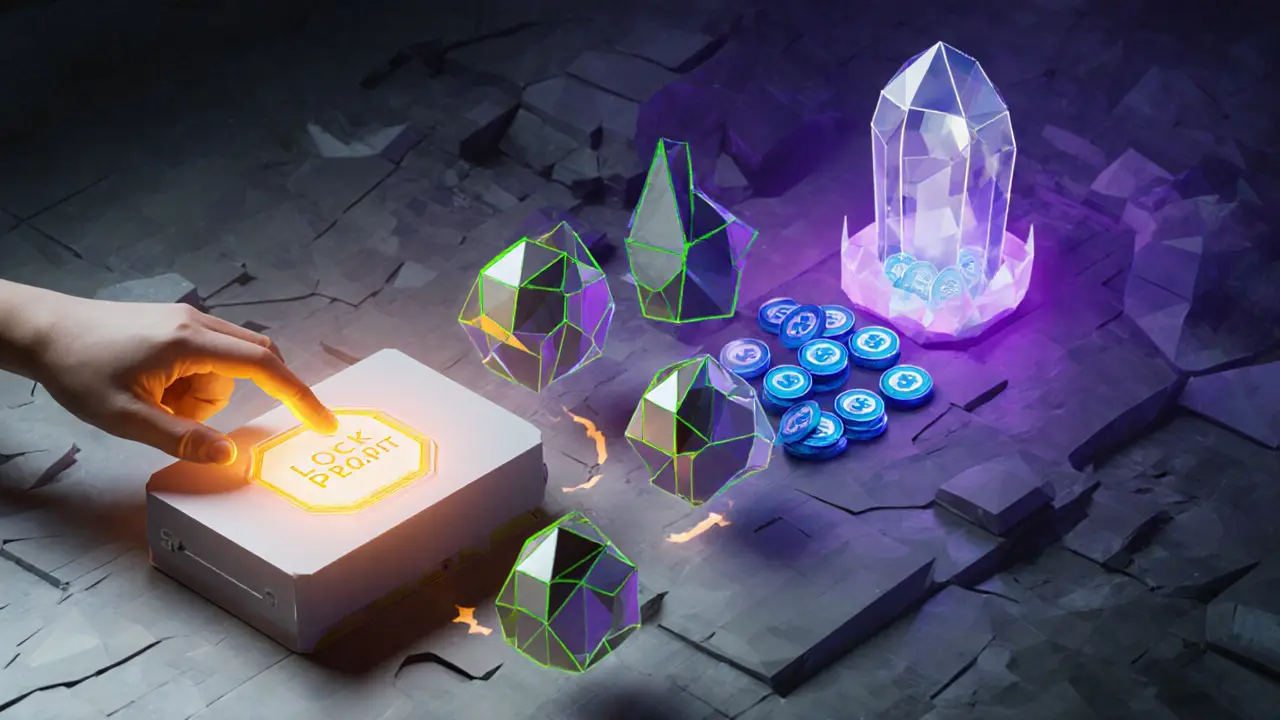Blockchain Bridges: How They Enable Asset Transfer
 Aug, 26 2025
Aug, 26 2025
Blockchain Bridge Transfer Simulator
Transfer Parameters
Transfer Steps
Transfer Simulation Results
Click "Simulate Transfer" to begin the simulation.
When you hear the term blockchain bridges, think of a digital tunnel that lets you move coins, tokens, or NFTs from one blockchain to another without losing value. In simple terms, a blockchain bridge is a protocol that connects two otherwise isolated networks, allowing assets to travel across chains while preserving ownership and security.
TL;DR
- Blockchain bridges lock assets on the source chain and mint wrapped equivalents on the destination chain.
- Two main designs exist: Wrapped Asset Method (most common) and Liquidity Pool Method.
- Security hinges on smart contracts, validator nodes, and cryptographic proofs.
- Bridges power cross‑chain DeFi, NFT marketplaces, and scalability solutions.
- Using a bridge involves connecting a wallet, selecting networks, confirming a lock transaction, and waiting for minting.
What is a Blockchain Bridge?
Blockchain Bridge is a protocol that acts as a gateway between two independent blockchains. It does not move the original coins; instead, it creates a representation of those coins on the target chain.
Because each blockchain has its own consensus rules, data formats, and native token standards, they cannot natively talk to each other. A bridge solves that incompatibility by providing a trusted layer of smart contracts and off‑chain validators that verify and relay state changes.
How the Transfer Process Works
The core workflow can be broken down into four stages:
- Locking: The user sends assets to a Smart Contract on the source blockchain. The contract holds the funds in escrow, effectively removing them from circulation.
- Proof Generation: Validator nodes or oracles monitor the lock transaction, create a cryptographic proof that the assets are securely held, and broadcast that proof to the destination chain.
- Minting: Upon receiving a valid proof, a Wrapped Token contract on the target blockchain mints a new token that is pegged 1:1 to the locked asset.
- Redeeming (reverse flow): To move assets back, the user burns the wrapped token on the destination chain. The bridge then releases the original asset from the escrow contract on the source chain.
This lock‑prove‑mint cycle guarantees that the total supply of the asset remains constant across both chains.
Two Main Bridge Architectures
While many bridges follow the same high‑level steps, they differ in how they source liquidity for the wrapped side. The two dominant models are the Wrapped Asset Method and the Liquidity Pool Method.
| Feature | Wrapped Asset Method | Liquidity Pool Method |
|---|---|---|
| Source of minted tokens | Created on‑demand after asset lock | Pre‑funded pool of native tokens on destination chain |
| Liquidity risk | Low - tokens are minted only when needed | Higher - pool can deplete if demand spikes |
| Speed | Depends on proof verification (often a few minutes) | Near‑instant once pool has sufficient depth |
| Security focus | Smart‑contract escrow & validator integrity | Pool management & potential front‑running attacks |
| Common examples | WBTC (Bitcoin → Ethereum), USDC (Ethereum → Solana) | THORChain, Anyswap (now Multichain) |

Key Players in a Bridge Ecosystem
Understanding the main components helps you assess risk and choose the right bridge.
- Validator Node - Off‑chain actors that watch the source chain, generate proofs, and broadcast them. Some bridges use a decentralized set of validators; others rely on a single operator.
- Oracle - Provides authenticated data about the lock transaction, especially in cross‑chain setups where direct node communication is impossible.
- DeFi Protocol - The destination ecosystem (e.g., lending, DEX) that consumes wrapped tokens for yields, swaps, or collateral.
- NFT - Non‑fungible tokens can also be wrapped, enabling cross‑chain marketplaces.
Why Bridges Matter for DeFi and Beyond
Interoperability is the holy grail of crypto. Bridges unlock three big advantages:
- Expanded liquidity: Users can move capital from a congested chain (like Ethereum during a gas‑spike) to a cheaper, faster network (such as Polygon or Solana), then bring it back when fees normalize.
- Multi‑chain strategies: Yield farms and lending platforms on different chains often offer varying APYs. With bridges, a savvy investor can chase the best rates without selling and rebuying assets.
- Cross‑chain applications: Projects like Curve Finance or Aave use bridges to allow a single interface to interact with assets across Ethereum, Avalanche, and Fantom, delivering a seamless user experience.
Beyond finance, bridges let artists port NFTs to new marketplaces, game developers move in‑game assets across blockchains, and enterprises integrate public‑chain data with private‑chain solutions.
Step‑by‑Step: Using a Bridge
Here’s a practical walkthrough for a typical user wanting to move USDC from Ethereum to Solana.
- Visit a reputable bridge platform that supports the Ethereum‑Solana pair (e.g., Wormhole or Allbridge).
- Connect your Ethereum‑compatible wallet (MetaMask, Ledger, etc.) to the bridge UI.
- Select “USDC” as the asset, set the amount, and choose “Solana” as the destination.
- Confirm the transaction. The bridge’s Ethereum Smart Contract locks your USDC in escrow.
- Validator nodes generate a proof and send it to the Solana network.
- On Solana, the bridge’s Wrapped Token contract mints an equivalent amount of USDC‑SPL tokens.
- Open your Solana wallet (Phantom, Solflare) to see the newly minted USDC ready for use.
The reverse process is identical, except you burn the SPL‑USDC on Solana and the Ethereum contract releases the original USDC.
Security Considerations
Bridges have been high‑profile targets for hackers. The biggest risk stems from the smart contracts that hold locked assets. If a contract has a bug, attackers can siphon the escrowed funds.
- Audit pedigree: Choose bridges that have undergone multiple third‑party security audits (e.g., Quantstamp, Trail of Bits).
- Validator decentralization: A bridge run by a single entity is more vulnerable to insider attacks. Decentralized validator sets reduce this risk.
- Insurance pools: Some protocols maintain a reserve that compensates users in case of a breach.
- Gradual exposure: Transfer modest amounts first, verify that the bridge behaves as expected, then scale up.
Remember, the bridge itself is a custodian of assets. Treat it with the same caution you would a centralized exchange.
Future Trends in Cross‑Chain Bridging
The ecosystem is evolving fast. Upcoming advances include:
- Layer‑0 solutions: Projects like Polkadot and Cosmos provide native cross‑chain messaging, reducing reliance on external bridges.
- Zero‑knowledge proofs: zk‑rollups can verify asset locks with minimal data, speeding up minting and lowering fees.
- Standardized bridge APIs: Industry groups are working on common interfaces, making it easier for wallets and DApps to integrate multiple bridges seamlessly.
As multi‑chain DeFi matures, bridges will become as essential as internet routers-quiet infrastructure that powers the experience.

Frequently Asked Questions
What is the difference between a wrapped token and the original asset?
A wrapped token is a new token minted on a destination chain that represents the original asset 1:1. It can be used like any native token on that chain, but its value is backed by the locked original asset held in escrow.
Are blockchain bridges safe to use?
Safety depends on the bridge’s code audit, validator decentralization, and operational history. Always start with small amounts, verify audits, and prefer bridges with insurance or proven track records.
How long does a typical cross‑chain transfer take?
Most bridges complete within a few minutes, but latency can rise to 15‑30 minutes during network congestion or when proofs require multiple confirmations.
Can I bridge NFTs across chains?
Yes. NFT‑specific bridges lock the original token and mint a wrapped version on the target chain, preserving metadata and ownership.
What fees are involved in bridging?
Fees usually include the source‑chain transaction fee, a validator/oracle fee, and the destination‑chain minting fee. Some bridges also add a small service charge.


Lexie Ludens
August 26, 2025 AT 11:06Wow, the whole bridge idea feels like watching a high‑wire act without a safety net-so exhilarating and terrifying at the same time!
Every time I think I’ve grasped the lock‑mint‑redeem cycle, another shiny token pops up and I’m left gasping.
It’s like the blockchain universe is playing a drama where the protagonist is constantly on the brink of collapse.
Honestly, the risk‑reward dance makes my heart race, and I can’t help but feel the adrenaline surge with each simulated transfer.
But deep down, I’m terrified that one slip could send everything spiraling into oblivion.
Aaron Casey
August 28, 2025 AT 18:40The interoperability layer introduced by blockchain bridges essentially serves as a cross‑chain protocol that abstracts state proofs via Merkle root verification, enabling atomic swaps across heterogeneous consensus mechanisms.
From a scalability perspective, the bridge's reliance on validator sets introduces both finality latency and potential centralization vectors.
Thus, when designing a production‑grade bridge, one must consider EVM compatibility, sharding implications, and the cryptoeconomic incentives that underpin the proof generation phase.
In practice, the lock‑mint paradigm aligns with optimistic rollup assumptions, while ZK‑based bridges leverage succinct proofs to mitigate fraud proofs.
Overall, the architectural trade‑offs dictate the bridge’s throughput and security posture.
Leah Whitney
August 31, 2025 AT 02:13That simulator really breaks down the steps in a clear way-locking, proof generation, minting, then redeeming.
It’s great for newbies who get lost in the jargon.
I love that you can pick different source and destination chains; it shows how versatile bridges can be.
If you run the simulation a few times, you’ll start to notice subtle gas fee differences between, say, Ethereum and Polygon.
Keep experimenting and you’ll build solid intuition about cross‑chain asset flows.
katie sears
September 2, 2025 AT 09:46In accordance with established cross‑chain protocols, the presented bridge simulation elucidates the sequential processes requisite for asset migration.
It systematically delineates the locking of tokens on the originating ledger, the subsequent cryptographic proof generation, the issuance of a wrapped counterpart, and finally the redemption mechanism.
This methodology adheres to the principles of trust‑minimized interoperability and provides a pedagogical framework for further scholarly examination.
Gaurav Joshi
September 4, 2025 AT 17:20Bridges sound cool but they also open doors for bad actors to exploit vulnerabilities we cant even see yet.
We need stricter regulations and community oversight before these things run wild.
Kathryn Moore
September 7, 2025 AT 00:53Bridges are just fancy wrappers.
Kimberly M
September 9, 2025 AT 08:26Love how simple the UI looks! 😊
The step‑by‑step flow makes the whole bridging concept feel less intimidating. 👍
AJAY KUMAR
September 11, 2025 AT 16:00Our country’s blockchain future cannot rely on foreign bridges that are riddled with hidden backdoors!
We must build indigenous solutions that protect our assets from external manipulation.
Only then can we claim true sovereignty in the digital realm.
bob newman
September 13, 2025 AT 23:33Oh great, another bridge that promises seamless transfers while quietly charging you a fortune in hidden fees.
Because who doesn’t love paying extra for the privilege of moving their own money?
Anil Paudyal
September 16, 2025 AT 07:06i think the lock step is pretty clear but the proof gen can be tricky sometimes.
Kimberly Gilliam
September 18, 2025 AT 14:40Honestly this whole bridge thing is just overhyped fluff that nobody really needs.
Jeannie Conforti
September 20, 2025 AT 22:13Nice job on the demo!
I think the lock step is easy to get, just send your token to the contract.
Then the bridge does the proof thing and gives you a new token on the other chain.
When you want it back just burn the new token and the original comes home.
tim nelson
September 23, 2025 AT 05:46I feel you, Anil – the proof generation can seem like black magic at first.
But once you see the math behind Merkle proofs, it all clicks into place.
Take your time, play with the simulator, and the process will become second nature.
Zack Mast
September 25, 2025 AT 13:20The bridge, in its essence, mirrors the human desire to connect disparate worlds, yet it remains bound by the immutable rules of cryptography.
Each locked token is a promise, each minted token a reflection, and each redemption a return to origin.
We are, perhaps, witnessing the digital manifestation of ancient alchemical transmutation.
Dale Breithaupt
September 27, 2025 AT 20:53Exactly, Zack! Think of it as a crypto‑alchemy lab where you get to experiment safely.
Every successful mint is a win, every redemption a victory.
Keep pushing those simulations and you’ll master the art of cross‑chain flows in no time!
Rasean Bryant
September 30, 2025 AT 04:26Bridges are opening doors to so many possibilities – gaming assets, DeFi yield, even NFT marketplaces across chains.
Imagine the future where a player can move their in‑game sword from Ethereum to Solana with a single click.
The potential is huge and we’re just at the beginning.
Angie Food
October 2, 2025 AT 12:00Sure, Rasean, but every time a new bridge launches, we see another hack or a rug pull.
Don’t get blinded by the hype; the technology is still brittle and the users are the real victims.
Jonathan Tsilimos
October 4, 2025 AT 19:33It is imperative to acknowledge that while bridging mechanisms facilitate asset fluidity, they concurrently introduce attack surfaces that demand rigorous audit regimes and formal verification to mitigate systemic risk.
Jerry Cassandro
October 7, 2025 AT 03:06Jonathan makes a solid point – always check if the bridge contract has undergone a third‑party audit.
Look for bounty programs that incentivize white‑hat researchers to find vulnerabilities.
That extra layer of scrutiny can save you from costly exploits.
Rochelle Gamauf
October 9, 2025 AT 10:40The naive optimism surrounding bridges betrays a fundamental misunderstanding of cryptographic security; only those with a deep grasp of consensus algorithms should venture into this arena.
Jerry Cassandro
October 11, 2025 AT 18:13When discussing blockchain bridges, it is essential to begin with the underlying trust model that dictates how assets are transferred across disparate ledgers.
At the core, most bridges employ a lock‑and‑mint paradigm, where the original asset is locked in a custodian contract on the source chain, and a representative token is minted on the destination chain.
This approach ensures that the total supply remains constant, preventing double‑spending across networks.
However, the security of this model hinges on the integrity of the validator set responsible for generating and attesting to the cryptographic proof of lock events.
In decentralized bridges, these validators are often selected via staking mechanisms that align economic incentives with honest behavior.
Conversely, centralized bridges rely on a single entity or consortium, which simplifies coordination but introduces a single point of failure.
The proof generation phase can be implemented using either optimistic fraud proofs, which assume correctness and allow challenges, or zero‑knowledge succinct proofs that provide mathematically verifiable assurance without disclosure.
Optimistic designs, while more gas‑efficient, require a challenge window during which malicious actors could attempt to submit fraudulent proofs.
Zero‑knowledge constructions, on the other hand, demand significant computational resources to generate but eliminate the need for challenge periods, offering near‑instant finality.
After a valid proof is confirmed, the destination bridge contract proceeds to mint the wrapped token, which typically adheres to the same ERC‑20 or ERC‑721 standards as the original asset.
This minting step must also update metadata to reflect provenance, especially for NFTs where uniqueness is paramount.
When a user wishes to retrieve the original asset, they initiate a redeem transaction, burning the wrapped token and signaling the source bridge to release the locked asset.
The redeem process must be carefully synchronized to prevent race conditions that could be exploited for replay attacks.
Furthermore, bridges must handle fee structures transparently, accounting for gas costs on both chains and any bridge‑specific service fees.
In practice, thorough testing, formal verification of smart contracts, and regular security audits are indispensable to maintaining user trust in cross‑chain interoperability.
Parker DeWitt
October 14, 2025 AT 01:46Jerry’s deep dive is impressive, but let’s not forget that even the most audited bridges can be compromised – just look at recent exploits 😒.
Allie Smith
October 16, 2025 AT 09:20Bridges remind us that barriers are often mental; in the crypto world, we have the tools to literally dissolve them and explore new frontiers of value.
Shelley Arenson
October 18, 2025 AT 16:53Well said, Allie! 🌉🚀
vincent gaytano
October 21, 2025 AT 00:26What no one tells you is that many of these “bridges” are secretly controlled by a handful of shadow entities that manipulate transaction proofs to siphon off assets.
They embed hidden backdoors in the validator code, allowing them to approve fraudulent lock events while the rest of us are none the wiser.
Stay vigilant and question every bridge you use.